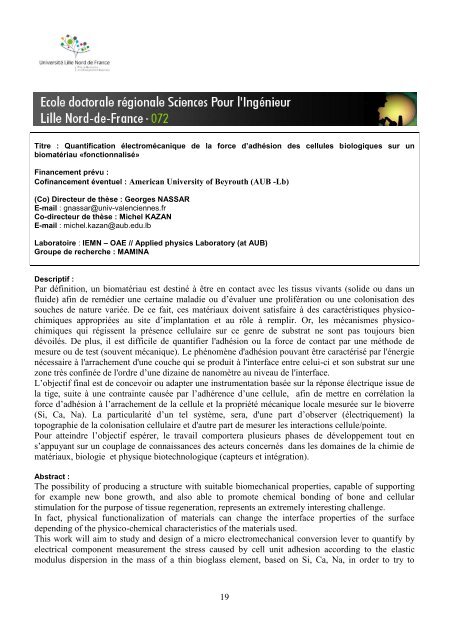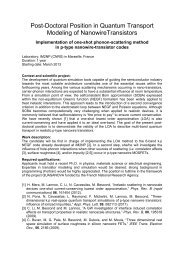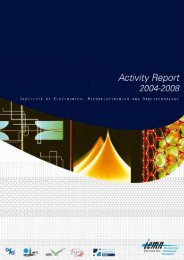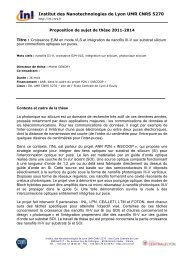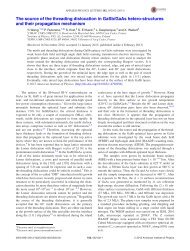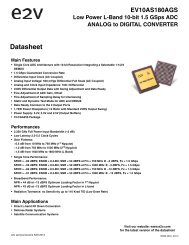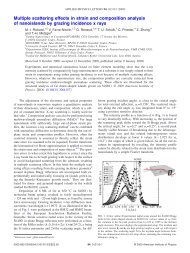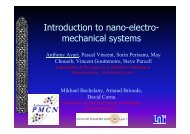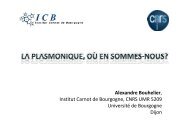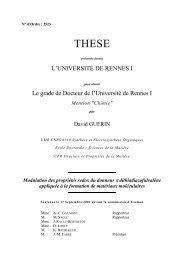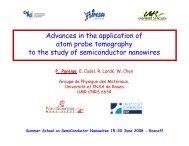Sujet de Doctorats 2013 - IEMN
Sujet de Doctorats 2013 - IEMN
Sujet de Doctorats 2013 - IEMN
- No tags were found...
You also want an ePaper? Increase the reach of your titles
YUMPU automatically turns print PDFs into web optimized ePapers that Google loves.
Titre : Quantification électromécanique <strong>de</strong> la force d’adhésion <strong>de</strong>s cellules biologiques sur unbiomatériau «fonctionnalisé»Financement prévu :Cofinancement éventuel : American University of Beyrouth (AUB -Lb)(Co) Directeur <strong>de</strong> thèse : Georges NASSARE-mail : gnassar@univ-valenciennes.frCo-directeur <strong>de</strong> thèse : Michel KAZANE-mail : michel.kazan@aub.edu.lbLaboratoire : <strong>IEMN</strong> – OAE // Applied physics Laboratory (at AUB)Groupe <strong>de</strong> recherche : MAMINADescriptif :Par définition, un biomatériau est <strong>de</strong>stiné à être en contact avec les tissus vivants (soli<strong>de</strong> ou dans unflui<strong>de</strong>) afin <strong>de</strong> remédier une certaine maladie ou d’évaluer une prolifération ou une colonisation <strong>de</strong>ssouches <strong>de</strong> nature variée. De ce fait, ces matériaux doivent satisfaire à <strong>de</strong>s caractéristiques physicochimiquesappropriées au site d’implantation et au rôle à remplir. Or, les mécanismes physicochimiquesqui régissent la présence cellulaire sur ce genre <strong>de</strong> substrat ne sont pas toujours biendévoilés. De plus, il est difficile <strong>de</strong> quantifier l'adhésion ou la force <strong>de</strong> contact par une métho<strong>de</strong> <strong>de</strong>mesure ou <strong>de</strong> test (souvent mécanique). Le phénomène d'adhésion pouvant être caractérisé par l'énergienécessaire à l'arrachement d'une couche qui se produit à l'interface entre celui-ci et son substrat sur unezone très confinée <strong>de</strong> l'ordre d’une dizaine <strong>de</strong> nanomètre au niveau <strong>de</strong> l'interface.L’objectif final est <strong>de</strong> concevoir ou adapter une instrumentation basée sur la réponse électrique issue <strong>de</strong>la tige, suite à une contrainte causée par l’adhérence d’une cellule, afin <strong>de</strong> mettre en corrélation laforce d’adhésion à l’arrachement <strong>de</strong> la cellule et la propriété mécanique locale mesurée sur le bioverre(Si, Ca, Na). La particularité d’un tel système, sera, d'une part d’observer (électriquement) latopographie <strong>de</strong> la colonisation cellulaire et d'autre part <strong>de</strong> mesurer les interactions cellule/pointe.Pour atteindre l’objectif espérer, le travail comportera plusieurs phases <strong>de</strong> développement tout ens’appuyant sur un couplage <strong>de</strong> connaissances <strong>de</strong>s acteurs concernés dans les domaines <strong>de</strong> la chimie <strong>de</strong>matériaux, biologie et physique biotechnologique (capteurs et intégration).Abstract :The possibility of producing a structure with suitable biomechanical properties, capable of supportingfor example new bone growth, and also able to promote chemical bonding of bone and cellularstimulation for the purpose of tissue regeneration, represents an extremely interesting challenge.In fact, physical functionalization of materials can change the interface properties of the surface<strong>de</strong>pending of the physico-chemical characteristics of the materials used.This work will aim to study and <strong>de</strong>sign of a micro electromechanical conversion lever to quantify byelectrical component measurement the stress caused by cell unit adhesion according to the elasticmodulus dispersion in the mass of a thin bioglass element, based on Si, Ca, Na, in or<strong>de</strong>r to try to19


